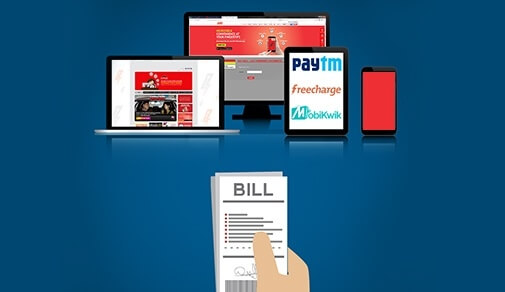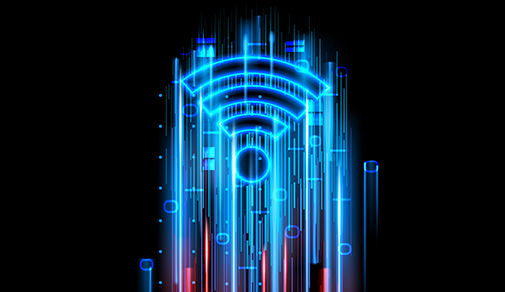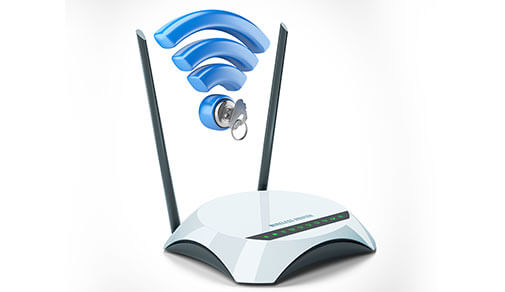In this day and age, quick and consistent connectivity is not a luxury but a necessity. Whether you are at home or working from office, a good WiFi connection is a must.
We have listed some blogs to help you choose the best home WiFi. We also have provided tips on how to manage your home WiFi so that there are no issues with your connectivity. In the blogs, we also look at how WiFi broadband plays an integral role in our lives and how ACT Fibernet is working towards reducing the digital gap in our country.
In this day and age, quick and consistent connectivity is not a luxury but a necessity. Whether you are at home or working from office, a good WiFi connection is a must.
We have listed some blogs to help you choose the best home WiFi. We also have provided tips on how to manage your home WiFi so that there are no issues with your connectivity. In the blogs, we also look at how WiFi broadband plays an integral role in our lives and how ACT Fibernet is working towards reducing the digital gap in our country.
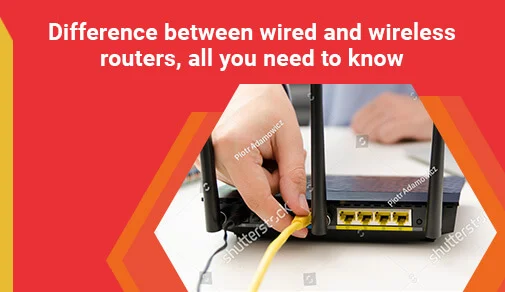
When you set up a home network, you can choose between a wired connection and a wireless network. Most wired connections will use Ethernet cables to connect your computer to a router or directly to your modem; you may also be able to use your home’s phone-line system with the right hardware. There are two types of routers - wired and wireless routers.
What is a Wireless Router?
A wireless router is directly connected by a cable to a modem. This enables it to collect data from the internet and send information to it. Then the router uses built-in antennas to build and connect with your home Wi-Fi network. As a consequence, there is internet connectivity for all the computers on your home network.
What is a wired router?
A wired router links directly to a device over a wired link. Usually, they have a port that links to the Internet to communicate with the modem. The wired router will attach to computers and other devices to transmit information through another port or ports.
Which is better - wireless or wired router?
In terms of performance, wired routers offer the best possible speeds. Most wired connections have a bandwidth of 10/100/1000 Mbps, with a wireless router offering a theoretical bandwidth of much less. Wired routers also have a consistent connection as they are literally plugged into the router, while wireless connections are remote sensitive, which means that the connection will degrade the further you get from the access point.
Disadvantage and advantages of a wired network
Generally, data transfer is faster than wireless networks. They are much less likely to suffer from interference than wireless networks. Also, It is more difficult for unauthorized users to intercept data.

offer 24x7 assured speeds?
Connect now to get the best of broadband plans and get additional offers on:
However, there are some disadvantages as well. Firstly, they are expensive to install or reconfigure. Secondly, users cannot instantly move a device from one location to another as they do.
Is a wired router faster than wireless?
In general, wired networks are much faster than wireless networks. This is mainly due to the fact that a separate cable is used to connect each device to the network with each cable transmitting data at the same speed. The wired network is also faster as it is never weighed down by unforeseen or unnecessary traffic.
Other things to know, also What features to expect from an excellent wired router.
Let's just point them out one by one.
Routing:
How fast hardware speeds up the path depends on the base forwarding. Suppose you have a Layer-3 base that means you get 2 million packets per second for 64-byte packets. All of the Modern Wired Router comes with this Layer-3 base forwarding.
Processor & Ram:
All routers have a processor and a Ram that enhances the overall performance of a router or the internet. This is another consideration before buying a wired router.
Ports:
Everyone knows that Gigabit is 10x faster than Ethernet. So, it would be better if the router had Gigabit ports. But routers come with both ports, such as 1x or 2x Gigabit ports with Ethernet ports (4x, 6x, 8x Ethernet ports).
Read tips and tricks to increase your wifi speed here
Be Part Of Our Network
All Categories
- BUSINESS INTERNET
- Router
- Internet Security
- Wi-Fi Connection
- Wi-Fi Network
- Internet Broadband
- smartfiber
- Internet Speed
- TV Streaming
- Wifi Connection
- BEST BROADBAND PLANS
- BROADBAND PLANS | 5GHz
- 2.4GHz
- 5GHz frequency
- 5GHz WiFi frequency
- 2.4GHz frequency
- LDRs
- LONG DISTANCE RELATIONSHIP
- ACT Fibernet
- wifi as a service

Find the perfect internet plan for you!
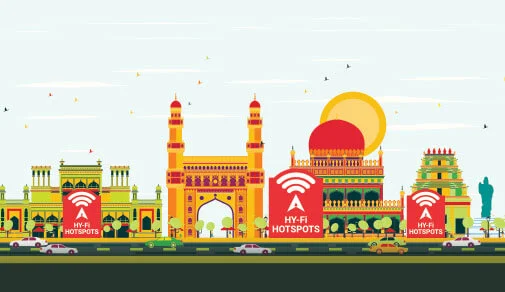
ACT Fibernet has become one of the most popular broadband service providers in the country, and it is also one of the few operators in the space which is offering speeds of up to 1 Gbps. ACT Fibernet has announced a partnership with the Hyderabad government to deploy Wi-Fi hotspots across the city. As per the latest release from ACT Fibernet, the initiative is part of the Smart City project which has been hatched by the government and will be carried out by the Hyderabad government.
With this project, the public will be able to seamlessly connect to the internet for free using the Wi-Fi hotspots. Many users will be able to log-in at one time to these Wi-Fi zones to experience high-speed internet for free from ACT Fibernet.
Users to Enjoy Up to 25 Mbps Speed
Users will be able to use the internet for 45 minutes with the speed of 25 Mbps to upload and download files, browse online, watch videos, visit social media handles and more. Below table summarizes the speeds that users can expect.
| Type | Free | Speed | FUP |
|---|---|---|---|
| Free | 45 min | 25Mbps | 1GB |
| Paid | 1 hour | 25Mbps | 2GB |
| Paid | 3 hours | 25Mbps | 4GB |
How to Login to the ACT Fibernet Public Hotspots:
You can follow the below steps to connect to the public Wi-Fi hotspots and enjoy Wi-Fi connectivity.

offer 24x7 assured speeds?
Connect now to get the best of broadband plans and get additional offers on:
- Users will be connected to ACT fibernet WiFi SSID at the respective hotspot locations.
- Users will be prompted for their mobile number (Name and email are optional)
- We will send an SMS to the mobile number.
- If the mobile number registered with us, will be logged in as existing customer
- Else, will be logged in as guest customer (45 minutes validity)
Benefits of Public Wi-Fi Hotspots
Free
The majority of public WiFi networks are free. As a result, you'll save a lot of money on data rates and be able to complete all of your internet-related duties on the go on your individual mobile devices at a reasonable speed.
Public WiFi promotes productivity
Anything that encourages movement is beneficial to productivity. To encourage client mobility, public WiFI is frequently offered in significant business locations such as airports, malls, cafes, and train stations. From the perspective of enterprises, this is critical because their staff will be able to work on their tasks while on the go, as long as they have a device to connect to the public WiFi network.
Useful for emergencies on the go
You can't foretell when an emergency will strike. It can happen anywhere, at any moment, and without warning. In an emergency, public WiFi works wonders and can provide a slew of benefits to help you regain control of the situation.
Benefits the Students Access Internet
I suppose this is a self-evident point. The fact that the majority of public WiFi services are free was already mentioned above. As a result, students who are travelling on a restricted budget can really profit from it.
Read tips and tricks to increase your wifi speed here
Be Part Of Our Network
All Categories
- BUSINESS INTERNET
- Router
- Internet Security
- Wi-Fi Connection
- Wi-Fi Network
- Internet Broadband
- smartfiber
- Internet Speed
- TV Streaming
- Wifi Connection
- BEST BROADBAND PLANS
- BROADBAND PLANS | 5GHz
- 2.4GHz
- 5GHz frequency
- 5GHz WiFi frequency
- 2.4GHz frequency
- LDRs
- LONG DISTANCE RELATIONSHIP
- ACT Fibernet
- wifi as a service

Find the perfect internet plan for you!

Despite the fact that connectivity is becoming increasingly important, millions of Indians still do not have access to the internet. A year after COVID-19 compelled the country to operate online, the digital divide, or the gap between those who have access to computers and high-speed internet and those who do not, is still preventing millions of Indians from working and learning at home.
What is the significance of the digital divide?
According to the Pew Research Center, more than half of people in 32 of the 34 nations studied use the internet at least occasionally or own a smartphone. As a result, those who do not have access to the internet may face serious consequences.
Individuals may be unable to get services, news and information, social interactions, or employment prospects if they do not have access to the internet. As more important services, such as vaccine scheduling, unemployment benefits applications, and medical visits, become predominantly internet-based, the repercussions of the digital divide will only grow.
What are some of the variables that contribute to the digital divide?
When it comes to internet connectivity, many Indians are having problems. According to a recent Oxfam survey, up to 80% of Indian students were unable to access online instruction during the lockdown, and many will not return to their courses when they reopen. That's just one example of how the pandemic has widened the country's digital divide — the barrier between those who have the resources and expertise to benefit from the internet and those who don't — aggravating already high levels of inequality and putting a damper on economic growth. While the disparity isn't unique to India, it's especially pronounced in a country where more than half of the 1.3 billion people are under the age of 25.
The digital divide exists as a result of two issues: access and affordability. As a result, the predominant demographics of persons without internet access are rural populations and low-income households.
Accessibility:
Bridging the digital divide between rural and urban inhabitants is particularly difficult because rural broadband expansion is a costly and time-consuming procedure. The government has spent billions of dollars developing rural internet connection over the last five years. Despite these expenditures, broadband connectivity remains a problem.
Affordability:
Despite the fact that millions of Indians live in urban areas and have access to multiple internet providers, they still do not have internet connection. According to the Pew Research Center, more than half of Indians who do not have access to the internet believe it is because it is too costly.
What internet connection speeds do Indians require?
The industry standard for high-speed internet is 25 megabits per second (Mbps) download and 3 megabits per second upload. However, it is believed that over 90% of Indians with internet connection have download rates of at least 100 Mbps.
Broadband expansion for rural and low-income families will still result in a big split in internet speeds, as the gap between 25 Mbps, 100 Mbps, and 250 Mbps is enormous. With only 25 Mbps, for example, a complete family would struggle to work and learn remotely. 100 Mbps, on the other hand, is enough for two to three family members to share, and 250 Mbps is enough for five to six family members to share.
India and Internet Access:
With 600 million internet users, India ranks second in the globe, accounting for more than 12% of all internet users. According to government data, half of India's population lacks internet connection, and even if they do, just 20% of Indians know how to use digital services.
India has the world's second-largest pool of internet users, with 600 million users accounting for more than 12% of all users worldwide. According to government data, half of India's population does not have access to the internet, and even if they have, just 20% of Indians know how to use digital services.
Prior to the outbreak, government analysts predicted that India's digital transformation might release up to $1 trillion in economic value over the next five years. However, the crisis is unevenly dispersing these benefits and exacerbating socioeconomic disparities, with girls suffering more than boys and rural areas suffering more than urban regions.
Facets of India’s Digital Divide:

offer 24x7 assured speeds?
Connect now to get the best of broadband plans and get additional offers on:
Telecom Industry’s Growth:
In February 2020, the country had over 1,160 million cellular users, up from 1,010 million in February 2016, according to a study released by the Telecom Regulatory Authority of India (TRAI) in June. In five years, the number of subscribers has increased by 150 million, or 30 million per year. The increase in urban and rural subscribers was evenly divided, with urban subscribers increasing by 74 million (from 579 million to 643 million) and rural customers increasing by 86 million (from 431 million to 517 million). However, this increase simply reflects an increase in basic telecommunications infrastructure.
The Urban-Rural Divide:
According to the NSSO survey performed between July 2017 and June 2018, only 4.4 percent of rural households own a computer, compared to 14.4% in metropolitan areas. Only 14.9 percent of rural homes have access to the internet, compared to 42 percent of urban homes. Similarly, only 13% of people over the age of five in rural areas have access to the internet, compared to 37% in urban regions.
Regional Divide:
The number of people with access to computers and knowledge of how to use the internet varies substantially throughout states. In both rural and urban areas, Himachal Pradesh tops the country in internet connectivity. The state with the most computers in urban areas is Uttarakhand, whereas Kerala has the most computers in rural regions. Kerala is the state with the smallest gap between rural and urban areas.
Digital Gender Divide:
India has one of the world's largest gender gaps in technology access. According to the GSMA's 2020 mobile gender gap report, only 21% of women in India have access to the internet, while 42% of males have. According to the report, while 79 percent of men in the country own a cellphone, only 63 percent of women do. While financial constraints to owning a cellphone or laptop exist, cultural and social conventions also play a significant role. The disparity in mobile usage between men and women sometimes exacerbates other inequities for women, such as access to information, economic prospects, and networking chances.
Closing the Digital Divide:
India's digital divide is still wide, with more than 400 million people without internet access. In addition, there is a significant spatial digital gap (internet density in rural areas is lower than in metropolitan regions), as well as a significant gender digital difference (far fewer women have access to smartphones than men).
The Indian government is taking substantial effort to improve its information and technology skills in order to address the country's digital divide.
- India's Digital Future Government initiatives to expand internet connectivity in the country. On the linked website, you may learn more about Digital India. Among the efforts that fall within this heading are:
- The BharatNet project was initiated in 2011 with the goal of connecting India's villages and connecting 0.25 million panchayats over an optical fibre network (100 MBPS).
- The National Digital Literacy Mission and the Digital Saksharta Abhiyan were established by the government in 2014.
- The government announced various programmes as part of its Digital India campaign in 2015, with the goal of connecting the entire country.
- The PM Gramin Digital Saksharta Abhiyan was launched in 2017 with the goal of bringing digital literacy to 60 million rural Indian families.
- Because of the importance of digital literacy, India's Supreme Court has declared the ability to access the Internet as a basic right, incorporating it within Article 21 of the Constitution's right to privacy and right to education.
- Google India and Tata Trusts jointly established the Internet Saathi Program in 2015. The goal of this project is to help rural Indian women become more digitally literate.
- The National Optical Fibre Network (NOF-N) is a project that aims to provide broadband access to over two lakh (200,000) gramme panchayats across India.
- Unnati Project — Hindustan Petroleum Corporation Limited (HPCL), which aims to close the digital divide in schools by providing computer education to rural pupils from low-income families.
- Radio broadcasting is used for children in distant locations who are not online on Air Shiksha Vani, DAISY by NIOS for differently abled, and e-PathShala.
How ACT Fibernet has helped bridge the gap -
Providing Hotspots to Migrant Labour Camps in Bangalore:
Most of us hear & see the plight that migrant workers are undergoing during the pandemic. While we feel for their cause, our team at ACT went ahead and tried making a slight difference to their lives. We set up 8 wifi hotspots and 2 TVs connected with our 4K streaming device (to browse channels and watch movies) at the migrant labourer camp at Thanisandra (behind Manyata Tech Park) to provide communication and entertainment for 1000 people who are housed there. Today, they can browse the internet with 20 mbps speed and unlimited data.
Connecting Parks to Build a Smart City:
ACT Fibernet created Wifi Hotspots at Nageshwara Park, Chennai inaugurated by Dr. R. Natarajan IPS (MLA Of Mylapore and former DGP of TN) and Mr. Prakash IAS, Commissioner of Greater Chennai corporation on 6th March '2020 to help in building of smart cities.
Knowledge Centre Inaugurated in City Armed Reserve (CAR) Headquarters:
ACT Fibernet helped in creating a knowledge centre for children of City Armed reserve at the Police quarters of CAR headquarters at Mysore Road, Chamarajpet. The knowledge centre was set up with computers, library, educational material, etc. ACT Fibernet also conducted basic computer courses for the children.
Launch of DAISY software for the visually Impaired:
ACT Fibernet, along with Karna Vidya Foundation to develop a DAISY format to help blind students study 11th and 12th std syllabus of CBSE and TN state board. The whole syllabus can now be converted from text to speech format.
We, at ACT Fibernet, will continue to march towards digital inclusion!
You can know more about our CSR initiatives here.
Read tips and tricks to increase your wifi speed here
Be Part Of Our Network
All Categories
- BUSINESS INTERNET
- Router
- Internet Security
- Wi-Fi Connection
- Wi-Fi Network
- Internet Broadband
- smartfiber
- Internet Speed
- TV Streaming
- Wifi Connection
- BEST BROADBAND PLANS
- BROADBAND PLANS | 5GHz
- 2.4GHz
- 5GHz frequency
- 5GHz WiFi frequency
- 2.4GHz frequency
- LDRs
- LONG DISTANCE RELATIONSHIP
- ACT Fibernet
- wifi as a service

Find the perfect internet plan for you!
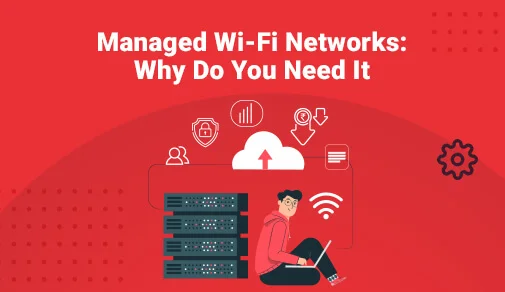
People nowadays demand instant connectivity – anywhere and at all times. The days of spotty connectivity and internet cables are long gone. When it comes to a business environment, having fast and easy access to Wi-Fi isn't just about convenience; it also has tangible benefits like increased productivity, reliability, and teamwork.
In 2021, consumers expect free, fast, reliable, and safe WiFi access from all businesses. To help their employees' day-to-day operations, offices rely on quick and reliable WiFi connections.
The company WLAN scenario has completely changed in the last decade; instead of managing a few access points (AP) to provide wireless hotspots for a limited number of workers, workplace Wi-Fi is now required to provide enterprise-wide coverage to hundreds of thousands of users. This is where a managed wi-fi network can be of use to many organisations.
What is Managed Wi-Fi?
Managed WiFi is an outsourced wireless network that connects tenants, visitors, and customers to the Internet through multiple access points within a building, ensuring property-wide access. It's a cloud-based technology, which means that Internet providers remotely control and troubleshoot a business' WiFi network, eliminating the need for an on-site IT department to do so.
A managed WLAN solution will cover the entire WLAN lifecycle, from developing, engineering, and deploying wireless systems to managing the entire network. Cloud managed Wi-Fi provides centralised management for user authentication and network control through a flexible subscription-based payment model.
Why do Businesses need Managed Wi-Fi?
The huge increase in the usage of smart mobile devices (there are currently over 2 billion smartphones worldwide) and the emergence of the BYOD (bring your own device) community has resulted in a corresponding increase in the demand for connectivity. Wi-Fi networks are now expected to link an increasing number of devices in a secure and timely manner.
Add in the massive increase in Internet use due to social media and other web-based applications, and you have a recipe for disaster. Employees expect high-speed networking to be available at all times and on every laptop, in addition to email access.

offer 24x7 assured speeds?
Connect now to get the best of broadband plans and get additional offers on:
Connectivity is essential for running a competitive company, whether you have a small office or a large corporation with many locations. Employees can step away from their desks and be more versatile with their work environment thanks to a well-managed wireless ecosystem, which generates and fosters a more positive work culture.
4 Benefits of Managed Wi-Fi
Below are the major benefits on Managed Wi-Fi networks -
Cost Effective:
Controlled WiFi is provided by an Internet provider, allowing companies to save money by eliminating the need for an on-site IT department to monitor and troubleshoot a property's WiFi while also gaining access to cutting-edge wireless technology and cyber-security experts.
Scalability:
Scalability is one of the most important advantages of regulated WiFi networks. Providers may use managed WiFi to simply add new access points or WiFi extenders to areas of a building where they find bad connectivity – before users even notice. Huge multi-unit apartment complexes, large national warehouse and chain-retail stores, hospitals, and enterprise offices will all benefit from this.
Reliability:
Nothing ruins efficiency more than a bad WiFi link (or one that is spotty). For several companies, this will include making their IT department diagnose the problem or enlisting the help of a professional. Those that use a Managed WiFi network have access to 24/7 dedicated support, which diagnoses, troubleshoots, and fixes WiFi issues remotely – without the need to come on-site.
Security:
In terms of protection, managed WiFi is a better choice than an internal IT department since it enables companies to outsource to qualified professionals. These security experts are well-versed in the best practises for configuring the most reliable networks and administrative controls. They will verify links and keep an eye on networks for possible threats and breaches.
You can know more about our enterprise business services here.
Read tips and tricks to increase your wifi speed here
Be Part Of Our Network
All Categories
- BUSINESS INTERNET
- Router
- Internet Security
- Wi-Fi Connection
- Wi-Fi Network
- Internet Broadband
- smartfiber
- Internet Speed
- TV Streaming
- Wifi Connection
- BEST BROADBAND PLANS
- BROADBAND PLANS | 5GHz
- 2.4GHz
- 5GHz frequency
- 5GHz WiFi frequency
- 2.4GHz frequency
- LDRs
- LONG DISTANCE RELATIONSHIP
- ACT Fibernet
- wifi as a service

Find the perfect internet plan for you!
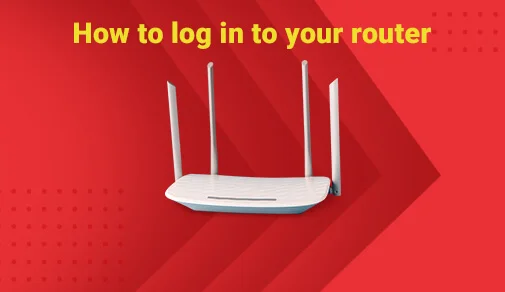
Your router, believe it or not, is not a "set it and forget it" computer. The most relevant settings for your home network are stored in your Wi-Fi router. Here's how to get access to yours and what you can do with it once you do.
Why Login to your Router?
- Change the name of your network and the password: TESCE423758768 initially seemed to be an ideal name for your Wi-Fi network. By logging into the device, you can change the default name and password whenever you want.
- Change the username and password for your router: This is the details you'll need to access your router's login page. For network protection, update as soon as possible from the usual.
- Select your level of security: To keep your confidential details safe from prying eyes, choose the best security mode.
- Choose a channel: Make the most of your device's dual channels. To transmit data, choose between the 2.4 and 5 GHz channels, or set your router to find the best channel automatically.
How to log in to your router?
There are a variety of ways to log in to a router depending on the manufacturer, but there are several commonalities that we can look to for the basics. To complete your login, you'll need your router login information as well as your IP address.
- Open a web browser such as Google Chrome, Microsoft Edge, or Apple Safari.
- In the search bar, type your IP address and press Enter.
- The login page for your router will appear. If you've already changed your password, enter your default username and password.
What if I don’t know my login credentials?
You can look up your default login details in the user's manual if you don't remember it. Some systems also have a password recovery feature, similar to what you'd find on your email or social media. Make sure you're next to your computer in case they ask for details like the serial number, which can be found on the bottom of your router.

offer 24x7 assured speeds?
Connect now to get the best of broadband plans and get additional offers on:
How do I log into my Netgear router?
You won't normally need the IP address to log in to a Netgear router.
- To access the routerlogin.com login page, go to https://www.netgear.com/home/services/routerlogincom.
- The username and password for Netgear devices are usually admin and password.
- To update your router settings, go to the homepage menu and choose Wireless.
How to use your Asus router?
You can find your Asus router's IP address by looking up your model in an index of Asus router models.
- To access your router's login page, type your IP address into your web browser.
- Asus computers typically come with admin as the default username and password.
- To edit your router settings, go to Wireless Settings on the left side.
How to access your Linksys router?
The IP address 192.168.1.1 is commonly used by Linksys routers.
- Enter 192.168.1.1 into your web browser's search box.
- The username: Access Router and the password: admin are the default login details for Linksys.
- To edit settings, go to the Wireless option in the general menu and choose Basic Wireless Settings.
Read tips and tricks to increase your wifi speed here
Be Part Of Our Network
All Categories
- BUSINESS INTERNET
- Router
- Internet Security
- Wi-Fi Connection
- Wi-Fi Network
- Internet Broadband
- smartfiber
- Internet Speed
- TV Streaming
- Wifi Connection
- BEST BROADBAND PLANS
- BROADBAND PLANS | 5GHz
- 2.4GHz
- 5GHz frequency
- 5GHz WiFi frequency
- 2.4GHz frequency
- LDRs
- LONG DISTANCE RELATIONSHIP
- ACT Fibernet
- wifi as a service

Find the perfect internet plan for you!
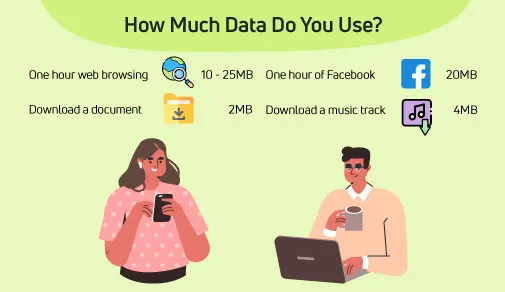
While purchasing a broadband for home or business, speed is everybody’s top priority. ACT Fibernet with its new revolutionary smart fiber technology is the best broadband for streaming in Hyderabad and Chennai. Also, ACT fibernet is the fastest wired broadband in Bangalore, Chennai, Jaipur, Coimbatore, etc.
How Much Data Do You Use?
This handy table shows how much data some standard online activities use. Bear in mind that the figures are only rough estimates. Your actual usage is likely to be around the amount we've cited, but could be more or less depending on a number of factors.
| Activity | Data consumption |
|---|---|
| One hour web browsing | 10 - 25MB |
| Download a document | 2MB |
| One hour of Facebook | 20MB |
| Download a music track | 4MB |
| Stream 30 minutes of YouTube | 175MB |
| Download a non-HD film | 700MB-1GB |
| Download an HD film | 4GB |
| Stream one hour of HD video | 2GB |
| Stream one hour of music or radio | 150MB |
Why Do You Need Unlimited Data Plans?
The primary reason for choosing an unlimited broadband plan is that if you reach a usage limit, you would not have to worry about incurring additional charges.
That is particularly important because you might be charged extra for internet use that is over and above the cap with 'limited' broadband deals. Which could land you with a bill that is very unwanted and unexpected.
ACT Fibernet’s Unlimited Plans in Hyderabad
The A-Max 1325 and Incredible 1999 plans priced at Rs 1,325 and Rs 1,999 offer 300 Mbps and 400 Mbps speeds. These are the two broadband plans in Hyderabad with unlimited data benefit. ACT Fibernet also increased the speeds on A-Max 1325 and Incredible 1999 plan.
Also, the A-Max 500 broadband plan, comes with a monthly rental of Rs 500 and offers 500GB of data at 40 Mbps speeds, after which the speeds will be reduced to 512 Kbps. Next up, we have the ‘Most Popular’ A-Max 700 broadband plan that offers 75 Mbps speeds, 1TB of FUP limit and 1 Mbps after FUP speeds. The A-Max 1075 plan comes with 150 Mbps speeds till the 2TB FUP limit, after which the speeds will be down to just 3 Mbps.
| ACT Fibernet Plans | Internet speeds | Monthly Data | Validity |
|---|---|---|---|
| Rs 500 | 40 Mbps | 500GB | 30 Days |
| Rs 700 | 75 Mbps | 1TB | 30 Days |
| Rs 1075 | 150 Mbps | 2TB | 30 Days |
| Rs 1325 | 300 Mbps | Unlimited Data (3,330GB) | 30 Days |
| Rs 1999 | 400 Mbps | Unlimited Data (3,330GB) | 30 Days |
| Rs 5999 | 1 Gbps | 6TB | 30 Days |
*As on date 25th Feb, 2021
ACT Fibernet’s Unlimited Plans in Chennai
The ACT Basic, ACT Blaze, ACT Blast Promo, ACT Storm, and ACT Lightning plans in Chennai have been upgraded to new speeds and industry-standard unlimited FUPs. The 60Mbps ACT Basic plan, which costs Rs 820 per month, will be available. The ACT Blaze plan will cost Rs 1020 per month and will have a download speed of 125Mbps, while the ACT Blast Promo plan will cost Rs 1075 per month and will have a download speed of 200Mbps. The ACT Storm plan will cost Rs 1125 per month and will provide 250Mbps, while the ACT Lightning plan will cost Rs 1325 per month and will provide 350Mbps.

offer 24x7 assured speeds?
Connect now to get the best of broadband plans and get additional offers on:
| ACT Fibernet Plans | Internet speeds | Monthly Data | Validity |
|---|---|---|---|
| Rs 549 | 40 Mbps | Unlimited Data (3,330GB) | 30 Days |
| Rs 820 | 75 Mbps | Unlimited Data (3,330GB) | 30 Days |
| Rs 1020 | 125 Mbps | Unlimited Data (3,330GB) | 30 Days |
| Rs 1075 | 200 Mbps | Unlimited Data (3,330GB) | 30 Days |
| Rs 1125 | 250 Mbps | Unlimited Data (3,330GB) | 30 Days |
| Rs 1325 | 300 Mbps | Unlimited Data (3,330GB) | 30 Days |
| Rs 1999 | 350 Mbps | Unlimited Data (3,330GB) | 30 Days |
| Rs 2999 | 1000 Mbps | Unlimited Data (3,330GB) | 30 Days |
ACT Fibernet’s Unlimited Plans in Bangalore
For Bangalore, ACT Fibernet provides ten broadband plans. The cheapest plan costs Rs 710 and the most expensive plan costs Rs 5,999. The unlimited broadband plans start at 1425 dollars per month and provide up to 250 megabits per second of internet speed. The package has a monthly data limit of 3,300GB.
| ACT Fibernet Plans | Internet speeds | Monthly Data | Validity |
|---|---|---|---|
| Rs 710 | 50 Mbps | 500GB | 30 Days |
| Rs 985 | 75 Mbps | 750GB | 30 Days |
| Rs 1085 | 150 Mbps | 1000GB | 30 Days |
| Rs 1185 | 200 Mbps | 2500GB | 30 Days |
| Rs 1425 | 250 Mbps | 3,300GB | 30 Days |
| Rs 1999 | 300 Mbps | 3,300GB | 30 Days |
| Rs 2999 | 300 Mbps | 3,500GB | 30 Days |
| Rs 3999 | 300 Mbps | 4,000GB | 30 Days |
| Rs 4999 | 300 Mbps | 4,500GB | 30 Days |
| Rs 5999 | 1000 Mbps | 5,500GB | 30 Days |
ACT Fibernet’s Unlimited Plans in Delhi
ACT Fibernet currently offers three broadband plans in Delhi, each of which includes a unique set of services in addition to high-speed Internet access. Let's look at the ACT Fibernet broadband plans in Delhi in more detail. The ACT Silver Promo, which offers 150 Mbps for 799, is the cheapest plan. The ACT Platinum promo, which offers 250 megabits per second for 1049, and the ACT Diamond promo, which offers 300 megabits per second for 1349, are the next two options.
| ACT Fibernet Plans | Internet speeds | Monthly Data |
|---|---|---|
| Rs 799 | 100 Mbps | Unlimited |
| Rs 1049 | 200 Mbps | Unlimited |
| Rs 1349 | 300 Mbps | Unlimited |
ACT Fibernet has the fastest internet speeds, up to 1 Gigabit per second in Chennai, Hyderabad and Banaglore. Our broadband plans can be found here.
Read tips and tricks to increase your wifi speed here
Be Part Of Our Network
All Categories
- BUSINESS INTERNET
- Router
- Internet Security
- Wi-Fi Connection
- Wi-Fi Network
- Internet Broadband
- smartfiber
- Internet Speed
- TV Streaming
- Wifi Connection
- BEST BROADBAND PLANS
- BROADBAND PLANS | 5GHz
- 2.4GHz
- 5GHz frequency
- 5GHz WiFi frequency
- 2.4GHz frequency
- LDRs
- LONG DISTANCE RELATIONSHIP
- ACT Fibernet
- wifi as a service

Find the perfect internet plan for you!

If your internet signal weakens when you move further away from your router, you may need this system to maintain a strong signal in your home.
If you're having trouble connecting in various parts of your house, you may have a wireless internet problem. And we all know that internet issues are not appropriate at this moment. The good news is that a small gadget known as a Wi-Fi extender will improve your poor connectivity to optimal levels.
What is a Wi-Fi Extender?
A Wi-Fi extender attaches to your router (via wireless or wired connection) to help expand your internet signal into rooms that are Wi-Fi dead zones due to walls, furniture, or general spacing. It's a stand-alone system that sits between your wireless router and the places where you'd like better Wi-Fi coverage.
How do Wi-Fi extenders work?
If your internet-connected computer and router have established a link, the Wi-Fi extender (also known as a Wi-Fi range extender) grabs the original signal and re-broadcasts it on a different channel than its current location, serving as a middleman to relay the connection. This will allow you to receive a wider range of wireless signals in your home.
Finding the ideal spot for your Wi-Fi extender is the most difficult task. It must be near enough to your router to pick up the signal, but far enough away to re-broadcast it to the room or place where you need more powerful home Wi-Fi.

offer 24x7 assured speeds?
Connect now to get the best of broadband plans and get additional offers on:
What’s the difference between a Wi-Fi extender, Wi-Fi repeater and Wi-Fi booster?
You can also come across products sold as a "Wi-Fi repeater" or "Wi-Fi booster." They all serve the same purpose: to improve and extend the range of your wireless signal. They do, however, operate in slightly different ways.
Wi-Fi extender –
This gadget operates by capturing and rebroadcasting an existing wireless signal on a separate channel. There's less risk of interference because it can link to your modem and router via coaxial cable or Ethernet cord. This means you'll have a good Wi-Fi signal in your house.
Wi-Fi repeater –
These first-generation extenders function in the same way, grabbing and rebroadcasting the existing signal. However, since it links wirelessly to your router on the same frequency as your router, you'll only get half of the usable bandwidth, resulting in higher latency.
Wi-Fi boosters -
Both Wi-Fi extenders and Wi-Fi repeaters are referred to as Wi-Fi boosters.
In case you are experiencing lag on your home wi-fi network, you can upgrade to ACT Fibernet to get faster speeds. View all broadband plans here.
Read tips and tricks to increase your wifi speed here
Be Part Of Our Network
All Categories
- BUSINESS INTERNET
- Router
- Internet Security
- Wi-Fi Connection
- Wi-Fi Network
- Internet Broadband
- smartfiber
- Internet Speed
- TV Streaming
- Wifi Connection
- BEST BROADBAND PLANS
- BROADBAND PLANS | 5GHz
- 2.4GHz
- 5GHz frequency
- 5GHz WiFi frequency
- 2.4GHz frequency
- LDRs
- LONG DISTANCE RELATIONSHIP
- ACT Fibernet
- wifi as a service

Find the perfect internet plan for you!
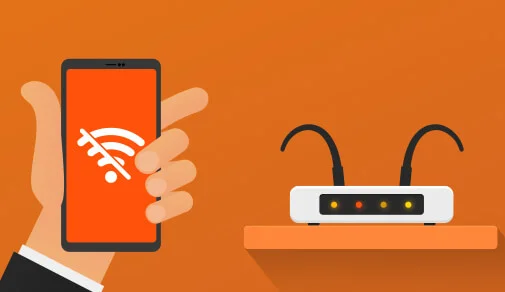
Use these troubleshooting guidelines to isolate and fix network issues relevant to your router. You can encounter more than one problem at the same time. When your Wi-Fi is down, you can restore connectivity on your own by troubleshooting some of these common problems.
Correct your Wi-Fi Security Settings
Test the following settings on all Wi-Fi devices to make sure they are compatible:
- Network Mode: The router must be allowed to accommodate all Wi-Fi models used by network clients. For example, routers designed to run in 802.11g mode only will not support 802.11n or old 802.11b devices. Adjust the router to run in mixed mode to remedy this kind of network failure.
- Security mode: Most Wi-Fi devices support several network security protocols (typically different variations of WPA and WEP). All Wi-Fi devices, including routers belonging to the same local network, shall use the same protection mode.
- Security key: Wi-Fi security keys are phrases or sequences of letters and digits. All devices that enter the network must be configured to use the Wi-Fi key recognized by the router (or wireless access point).
Update your Hardware or Firmware
The reason for this step is twofold. You can take benefit of any additional features and improvements of the new version of the firmware. Also, your router will normally receive any critical security updates.
Typically, you will have the choice of checking, evaluating, downloading, and installing the latest firmware on your router's administration tab. The exact steps depend on the make and model of your router, so check the specifics of the router manufacturer's support site.
 Looking for an internet plans that
Looking for an internet plans that
offer 24x7 assured speeds?Connect now to get the best of broadband plans and get additional offers on:






Fix Overheating or Overloading
You can set up a different Wi-Fi router or allow the "Guest Network" option for your router. You can also set up a separate SSID and password for your host network to avoid issues with your main network. This segregation would also work with your smart appliances and secure your key devices from attacks on the Internet of Things. You can also use QoS (Quality of Service). QoS is a feature on some routers that lets you prioritize traffic according to the type of data being transmitted.
Remove MAC Address Restrictions
A number of network routers support a function called MAC address filtering. While disabled by default, router administrators can turn this function on and limit connections to only those devices by their MAC address number. Check the router to ensure that either the MAC address filtering is off or the MAC address of the computer is included in the list of allowed connections.
Check Wireless Signal Limitations
If you have a newer router, check if it supports the 5GHz band. Newer routers typically have dual-band capabilities. By allowing dual bands, you could hold older devices that only support slower G specification on the 2.4GHz band and newer devices on the beefier and faster 5GHz band. Essentially, this is like having two routers in one.
Read tips and tricks to increase your wifi speed here
Be Part Of Our Network
All Categories
- BUSINESS INTERNET
- Router
- Internet Security
- Wi-Fi Connection
- Wi-Fi Network
- Internet Broadband
- smartfiber
- Internet Speed
- TV Streaming
- Wifi Connection
- BEST BROADBAND PLANS
- BROADBAND PLANS | 5GHz
- 2.4GHz
- 5GHz frequency
- 5GHz WiFi frequency
- 2.4GHz frequency
- LDRs
- LONG DISTANCE RELATIONSHIP
- ACT Fibernet
- wifi as a service

Find the perfect internet plan for you!

Wi-Fi protection is designed to avoid unauthorized access to wireless devices. Most home routers have several security modes that differ in levels of safety. Did you know that your internet connection uses one of four different types of security? While all of them are different, not all of them are equal; as such, it's important to learn what form of protection your Wi-Fi is using.
Various types of wireless security protocols have been developed for the safety of home wireless networks. Wireless security protocols are WEP, WPA, and WPA2, which serve the same function but are different at the same time.
The Wired Equivalent Privacy (WEP) Protocol
WEP was developed for wireless networks and introduced as a Wi-Fi security standard in September 1999. It is still prevalent in the modern era within older structures due to its age. Out of all protocols, WEP is considered to be the least stable. WEP was officially discontinued by the Wi-Fi Alliance in 2004.
The Wi-Fi Protected Access (WPA) Protocol
WPA arrived as WEP's substitute due to the vulnerabilities contained within WEP. It has additional features, such as the Temporary Key Integrity Protocol (TKIP). This function was a 128-bit dynamic key that was harder to break into than a WEP static, unchanged key. WPA was a major improvement over WEP, but as the core components were rendered so that they could be rolled out through firmware updates to WEP-enabled devices, they still relied on exploited elements.
 Looking for an internet plans that
Looking for an internet plans that
offer 24x7 assured speeds?Connect now to get the best of broadband plans and get additional offers on:






The Wi-Fi Protected Access 2 (WPA2) Protocol
WPA2 is the successor to WPA and adds more features to the mix. WPA2 replaced TKIP with the Counter Mode Cipher Block Chaining Message Authentication Code Protocol (CCMP), which did a better job of encrypting data.
WPA2 has been very popular and has retained its place as the top protocol since 2004. In reality, on 13 March 2006, the Wi-Fi Alliance announced that all potential Wi-Fi devices had to use WPA2.
The Wi-Fi Protected Access 3 (WPA3) Protocol
WPA3 is the new kid on the block, and you can find it in the routers that were created in 2019. With this new format, WPA3 introduces stronger security to public networks to prevent hackers from extracting information from them.
Which security method will work for your network?
Here is the list of new (after 2006) security approaches used on wireless networks, from the best to the worst:
- WPA2 and AES
- AES + WPA
- WPA + TKIP/AES (TKIP as a fallback method)
- WPA + TAKIP
- WEP The WEP
- Open your network (no security at all)
Read tips and tricks to increase your wifi speed here
Be Part Of Our Network
All Categories
- BUSINESS INTERNET
- Router
- Internet Security
- Wi-Fi Connection
- Wi-Fi Network
- Internet Broadband
- smartfiber
- Internet Speed
- TV Streaming
- Wifi Connection
- BEST BROADBAND PLANS
- BROADBAND PLANS | 5GHz
- 2.4GHz
- 5GHz frequency
- 5GHz WiFi frequency
- 2.4GHz frequency
- LDRs
- LONG DISTANCE RELATIONSHIP
- ACT Fibernet
- wifi as a service

Find the perfect internet plan for you!
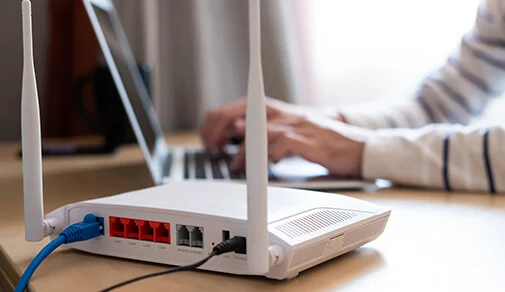
There are several reasons why you can encounter less than optimal wireless connectivity in your home. But before you leap to conclusions, it's worth asking yourself why you need to broaden your network in the first place.
Various Types of WiFi Extension - Which One Do you Need?
There are several different types of WiFi extension devices on the market, you'll see words like extender, repeater, booster, and more interchangeably used. However, they are not all the same
All of these are intended to do the same thing: make good WiFi available in more of your home. However they're not the only way to broaden and improve your established bond (or replace it entirely). Take a look at four types of WiFi extension devices below.
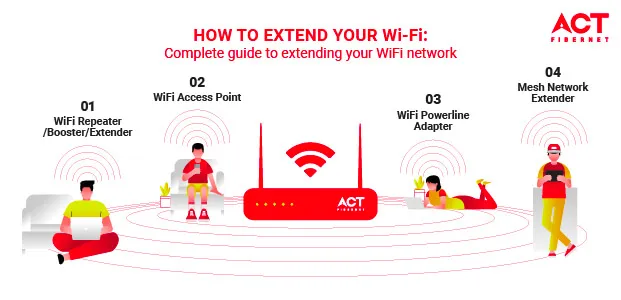
WiFi Repeater/Booster/Extender
The use of a wireless range extender is one of the best ways to increase range. These products repeat your current wireless signal, giving you a better Wi-Fi range without the need for any physical wiring. For better performance, you need to set the extender halfway between the current router and the area in which you get weak reception.
WiFi Access Point
A safer way to increase the wireless range is to use a dedicated wireless access point or secondary router that is connected to your first router via a physical wired network. This solves problems of latency and speed. Using this approach, you use the same network name and security key on your new access point as on your current router. For better results, you can use separate channels on each access point, so there is no interference.
 Looking for an internet plans that
Looking for an internet plans that
offer 24x7 assured speeds?Connect now to get the best of broadband plans and get additional offers on:






WiFi Powerline Adapter
Powerline adapters are a form of Wi-Fi access point that allows you to transmit a wired Ethernet link via the normal power outlet of your home. This allows a high-speed Internet link to be built just about anywhere you have an outlet in your house. For those residing in multi-story properties where cutting new cables is prohibitively costly (or even impossible) this can be an ideal option for providing high-quality internet connectivity to hard-to-reach spaces.
Mesh Network Extender
Mesh networks can simply be thought of as a collection of access points distributed around your house, working together to create a "mesh" of links, although this is not entirely true from a technological point of view. However this is basically how a mesh network functions; a number of nodes" provide distributed internet connectivity over a wide region. In reality, similar mesh networks have been used to cover entire cities, and even entire swaths of a world, in some circumstances.
Conclusion: Which Wi-Fi Extension Method Should You Choose?
- If your house is wired to ethernet and you have just a few "dead zones" in those areas: WiFi Access Point
- If your house is not wired to ethernet and you have just a few "dead zones" in those areas: WiFi Repeater
- If you only have quality coverage on one side of the house: WiFi Access Point
- If you have a larger or intermittent home: WiFi Mesh Network
Read tips and tricks to increase your wifi speed here
Be Part Of Our Network
All Categories
- BUSINESS INTERNET
- Router
- Internet Security
- Wi-Fi Connection
- Wi-Fi Network
- Internet Broadband
- smartfiber
- Internet Speed
- TV Streaming
- Wifi Connection
- BEST BROADBAND PLANS
- BROADBAND PLANS | 5GHz
- 2.4GHz
- 5GHz frequency
- 5GHz WiFi frequency
- 2.4GHz frequency
- LDRs
- LONG DISTANCE RELATIONSHIP
- ACT Fibernet
- wifi as a service

Find the perfect internet plan for you!
